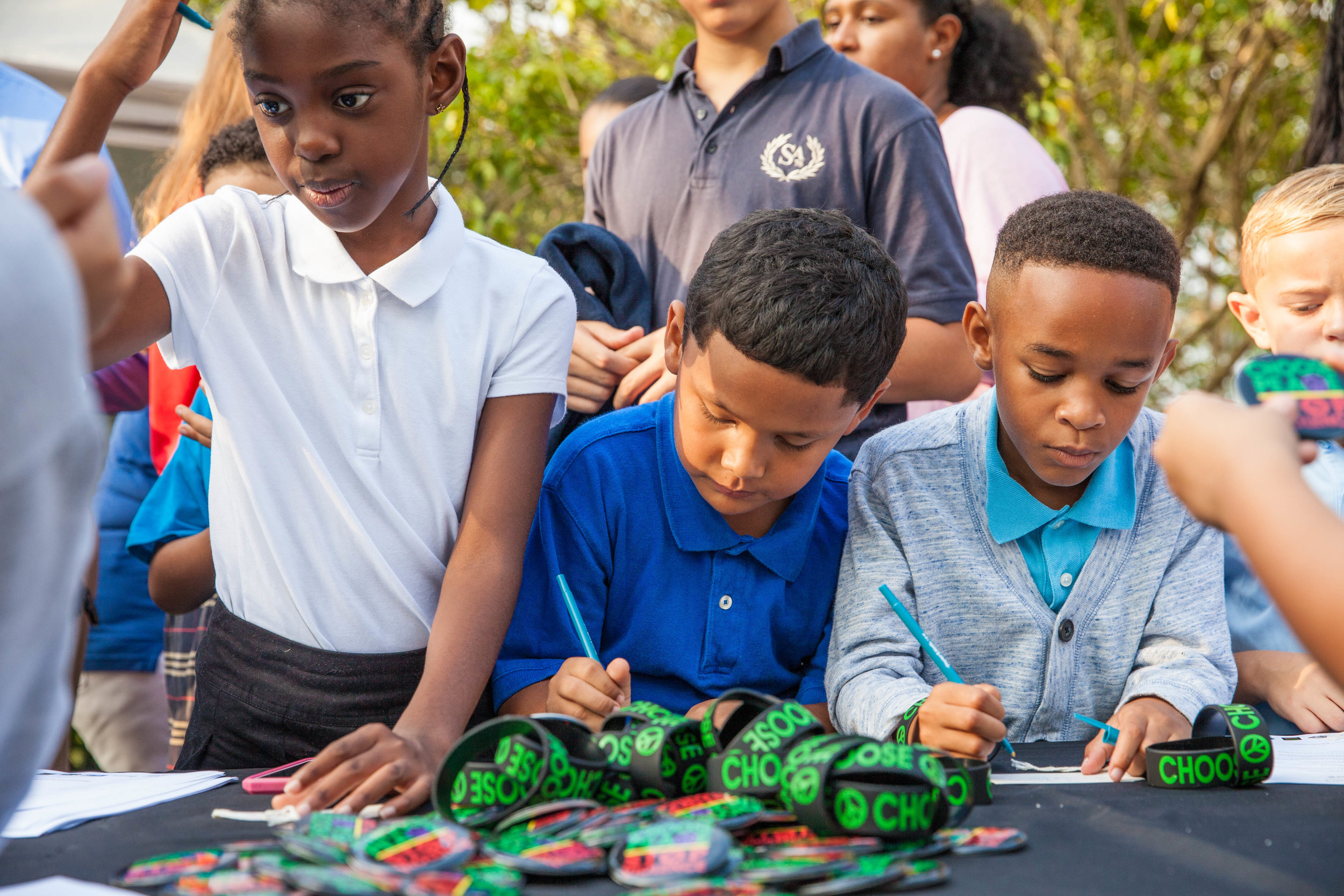
Campaign Nonviolence Action Days:
Working to Dismantle Forms of Violence
Rivera Sun / Waging Nonviolence
(October 5, 2023) — Children painting giant murals for peace and justice. Students learning de-escalation skills. Libraries displaying nonviolence books. Protesters sounding the alarm on the climate crisis. Activists blocking military bases.
During the 10th annual Campaign Nonviolence Action Days from Sept. 21 to Oct. 2, hundreds of local, national and international groups organized actions and events to build a culture of peace and active nonviolence, free from war, poverty, racism and environmental destruction. In 2023, a staggering 5,057 actions were planned across the United States and 20 countries. Over 60,000 people took part in these actions and events.
At first glance, their seemingly disparate issues are united only under a broad umbrella. After all, what does a silent minute of meditation have to do with a direct action to stop the climate crisis? Yet, a deeper look reveals the profound interconnection between the many forms of violence that bring people to the Campaign Nonviolence Action Days. Even more powerful is the interrelatedness of the solutions and alternatives that people are proposing.
We want a world beyond violence. We want a culture of active nonviolence. Across the issues, the many injustices people oppose bear the shared signature of systemic, structural and direct violence. People are tired of poverty, racism, war, shootings, climate disasters, militarism, hate crimes, xenophobia. As they stand up for change, each organizing group is putting into place a piece of the puzzle. The image it forms is a broad vision of a culture of peace and active nonviolence.
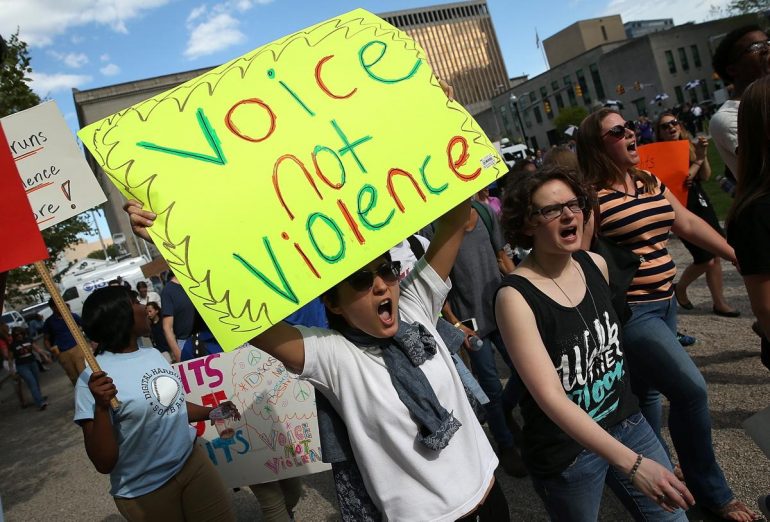
Many targeted protests this year
took the peace message to the doorstop of
the military-industrial complex
When Campaign Nonviolence began in 2014, a couple thousand people took part in 230 actions. Now, we’re seeing how this vision is shared by tens of thousands of people. Here are dozens of examples that show what a culture of active nonviolence looks like — and how many of us are willing to work for it.
One of the goals of Campaign Nonviolence is to “mainstream nonviolence,” taking the skills and practices out of the margins and into the heart of our communities. During Action Days, organizers go beyond the “usual suspects” and find ways to connect with unlikely allies, people who have never heard of nonviolence, and groups that don’t usually focus on these ideas. Urban gardens, bookstores, soup kitchens, even local bars: these are some of the places where people are taking action. Local teams are organizing participation among businesses (like soap makers in Lansing, Michigan), faith groups (like the 24-hour nonviolence vigil with a Tibetan Buddhist center in Louisville, Kentucky), or schools (like a district-wide peace essay contest in Little Rock, Arkansas).
Public libraries were major nonviolence champions this year. In Olean, New York, the library put up a month-long display on nonviolence and held two related author talks. The library in Beaverton, Oregon, hosted an event on peace, welcoming immigrants and preventing gun violence.
In Owensboro, Kentucky, the library opened its doors to an anti-nuke documentary film screening and origami crane folding that will decorate a peace Christmas tree display later this year. In Caro, Michigan, organizers held a teach-in on nonviolent action at the library using the documentary film “A Force More Powerful.” Partnering with Nonviolent Seaford, the Seaford District Library in Delaware put up tables with nonviolence pamphlets, posters, training materials and nonviolent action coloring pages.
Education is an important part of Campaign Nonviolence’s goal of building a culture of peace and active nonviolence. This year, we called upon people to host nonviolence teach-ins, especially on Oct. 2, Gandhi’s birthday and the International Day of Nonviolence.
A group in Louisville, responded to this call-to-action by holding daily nonviolence practice sessions each morning during Action Days. On Earth Peace hosted a virtual Kingian Nonviolence training. A peace group in Milwaukee held a peace action teach-in. In Tucson, Arizona, a university held a youth conference focusing on forms of nonviolence toward oneself, including self-care, empathy and mental health.
Portland Peace Team held a nonviolent resistance training in honor of nonviolent strategist Rev. James Lawson’s 95th birthday. Ignite Peace in Cincinnati, Ohio, took people on a deep-dive with a strategic nonviolence intensive. In Salem, Oregon, a nonviolent direct action training was offered as part of a campaign against a local weapons manufacturer making parts for nuclear weapons. An in-depth retreat in Kingston, New York, focused on “Nonviolence Is Our Future” with Kazu Haga and other presenters. Nearly 100 people joined the Nonviolence Study and Practice Group for a film screening and discussion of “The Third Harmony.”
And the list goes on. On Oct. 2, youth in Opelika, Alabama, discussed “How the Nonviolence Movement Affects Our Generation.” The Peace Resource Center in San Diego hosted a lively discussion titled “What’s Your Nonviolence IQ?” Casa Esperanza Catholic Worker launched a 5-week virtual training on “The Intersection of Nonviolence and Care for Creation.” Friends of the Gandhi Museum in Pune, India, took to the streets to distribute nonviolence literature. In Gambia, multiple days of training were held on a sunlit beach with 70 participants.
In Germany, Malawi, Pakistan and Togo, educational events addressed social injustice, war, gender-based violence and street harassment. World BEYOND War’s virtual conference, “Nonviolent Resistance To Militarism,”brought 300 people together to hear from organizers in Honduras, Mexico, Colombia, Ecuador, Ukraine and beyond.
Speaking of antiwar organizing, peace groups have been a backbone of Campaign Nonviolence Action Days since our inception. This year’s organizing included many targeted protests that took the peace message to the doorstop of the military-industrial complex.
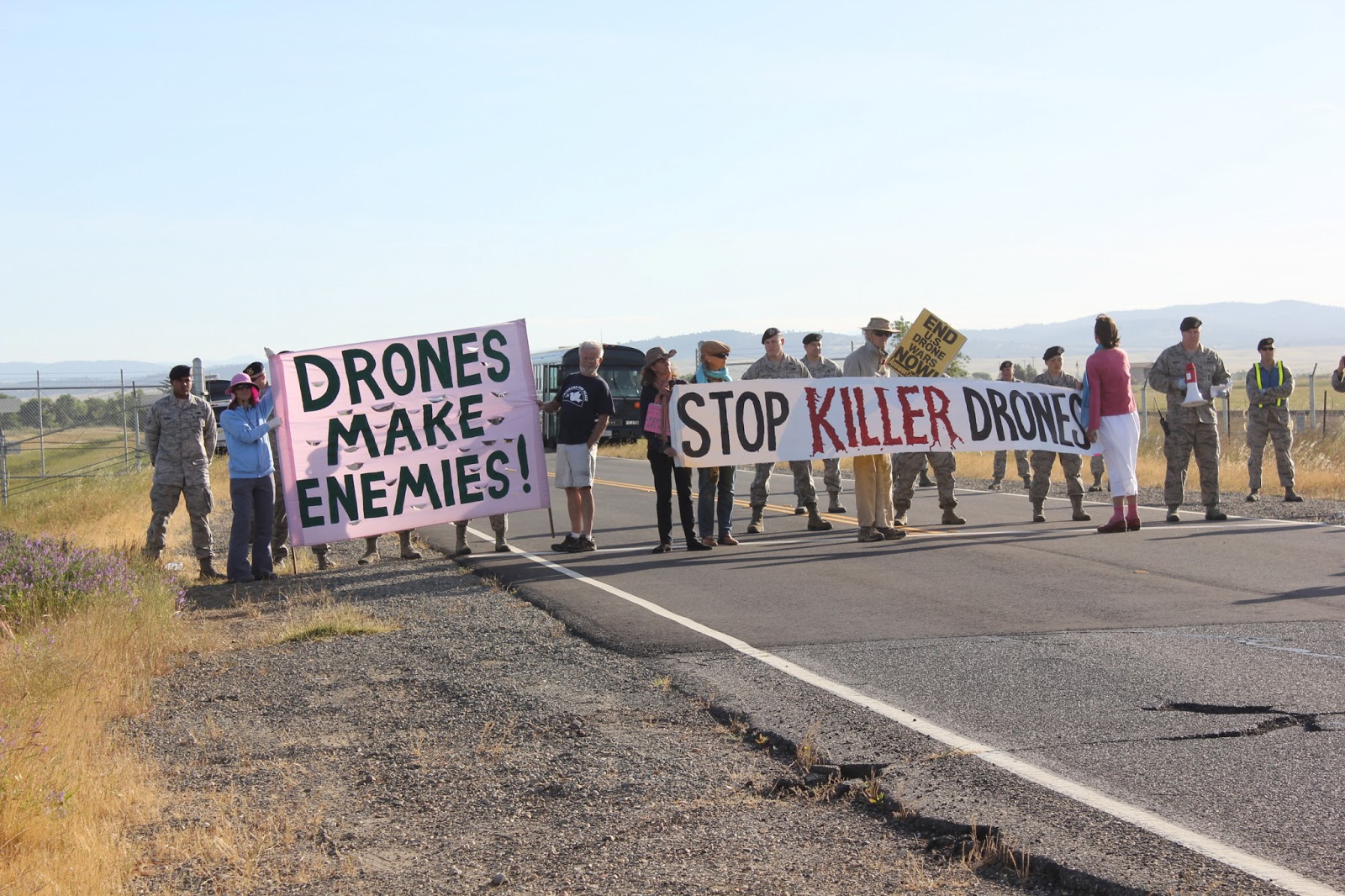
In California, a demonstration at the gates of Beale Air Force Base drew links between militarism and the climate crisis. In San Diego, Veterans For Peace held overpass banner actions to oppose the blatant militarism of fighter jet fly-overs during the Miramar Air Show. In Maryland, a group held a vigil at the doors of the Air Force Association’s Arms Bazaar where the major players in the weapons industry gathered. In New York City, Pax Christi New York State held a rally at the United Nations for the total elimination of nuclear weapons.
In Santa Fe, New Mexico, a picket raised the issue of nuclear waste and the problems facing the US’ only long-term storage facility. Women Against Military Madness held an anti-war vigil on a bridge in Minneapolis. Zaporizhzya Protection Project was in Ukraine, organizing unarmed civilian protection to keep the Zaporizhzya nuclear power plant safe from war-related meltdowns.
By starting our efforts on Sept. 21, the International Day of Peace, and ending on Oct. 2, the International Day of Nonviolence, we’ve seen people increasingly understand that nonviolence is the means to the ends of peace. On the local level, groups are connecting the yearning for peace with the pragmatic work of ending violence, especially among youth.
One of our partner groups, Sandy Hook Promise, held its annual Start With Hello Week from Sept. 18-24, reaching out to hundreds of classrooms to teach students how to break down social isolation, one of the factors in school shootings. In Detroit, Meta Peace Team trained an incoming freshman class in violence de-escalation skills, part of their multi-year effort to infuse school culture with student-led responses to violence.
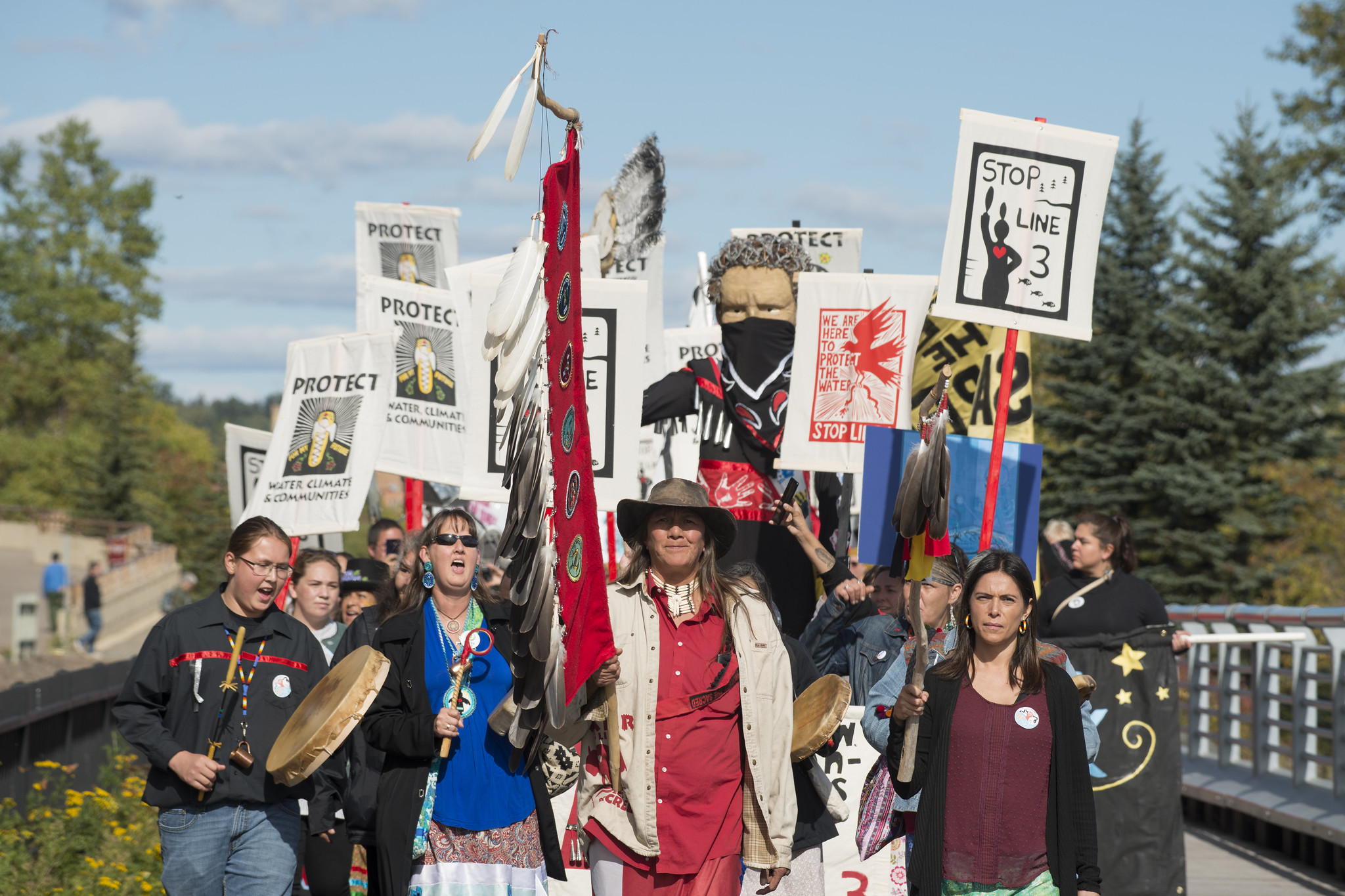
In Honolulu, a low-income neighborhood renewed its commitment to be a Zone of Peace and Nonviolence, holding a rally, march and community events. Peace Day Philly organized a 165-person “Footballs Not Firearms” march and rally to prevent gun violence. Free footballs were donated by the Eagles and touch football was played at the rally.
Other youth-centered efforts include Arkansas Peace Week’s impressive peace art contest, which received over 2,000 submissions and displayed the finalists’ work at the Arkansas State Capitol Rotunda. They also coordinated the Wildcats Walk For Peace at an elementary school in Little Rock, with 375 students marching through the neighborhood, chanting: “P-E-A-C-E, Wildcats Walk for Peace!”
Campaign Nonviolence’s vision is to help people see nonviolence as multi-dimensional. We can practice it toward ourselves (such as the community street festival in New York filled with free sessions with health and wellness practitioners), with one another (such as the conflict and nonviolent communication skills learned by an entire congregation in Colorado), and toward society through nonviolent action to eliminate structural and systemic violence. Yet, there is another application of nonviolence which is increasingly needed: nonviolence toward the Earth.
With the climate crisis heating up and disasters hitting communities hard, climate action is a major focus in Campaign Nonviolence. At the White House, a group of climate protesters with Nonviolence International engaged in civil disobedience to get President Biden to declare a climate emergency.
Campaign Nonviolence’s Earth Action Team held Sound The Alarm For Climate Action protests at town offices, cultural events and churches in Maine, New York and Michigan. They set their phone alarms to go off and when the noise interrupted the events, they stood up and gave a short speech on the climate crisis, ending with “Time’s up. What are you/we going to do?”

One long-term vision of Campaign Nonviolence
is to make what we experience during Action Days
an everyday occurrence in our lives
Twin Cities Nonviolent, one of the sites with our Nonviolent Cities Project, held two environmentally-themed musical actions as part of their 12 Days Free From Violence. On Sept. 30, the symphony group Classical Uprising performed “The (Uncertain) Four Seasons,” Vivaldi’s classic with a climate twist. On Sept. 25, another group performed “A Prophetic Opera For Our Times” with readings on humanity and our connection to the Earth. Twin Cities Nonviolent also participated in the “Hands Across the Mississippi March” that had an emphasis on clean water, air and land.
This is just a glimpse of the more the 5,000 actions and events that took place. Campaign Nonviolence also mobilized people to engage in mutual aid solidarity, racial healing, divestment from weapons and fossil fuels and much more.
One of the long-term visions of Campaign Nonviolence is to make what we experience between Sept. 21-Oct. 2 an everyday occurrence in our lives. Imagine it: walking through our day, we encounter opportunities to remember the principles of nonviolence. Everybody we know attends workshops in interpersonal conflict skills (maybe after yoga class). Restorative justice in schools and beyond is the norm, not the exception. Every student, bus driver, teacher and librarian learns how to de-escalate violence. Friends and family understand nonviolent action and join protests, boycotts and strikes on a regular basis.
Businesses share the ethic of doing no harm, treating workers well and cleaning up their messes. Workers are organized and accustomed to using strikes and pickets, not just for better wages, but in support of social justice causes.
Institutions take strides to be fair, inclusive and diverse. Nations disarm and downsize their military, choosing instead to fund peace teams and diplomacy rooted in justice. Our cities run on renewable power and widespread efforts focus on regenerative and restorative practices for ecosystems. Everywhere we look, our society prioritizes care of people and the planet.
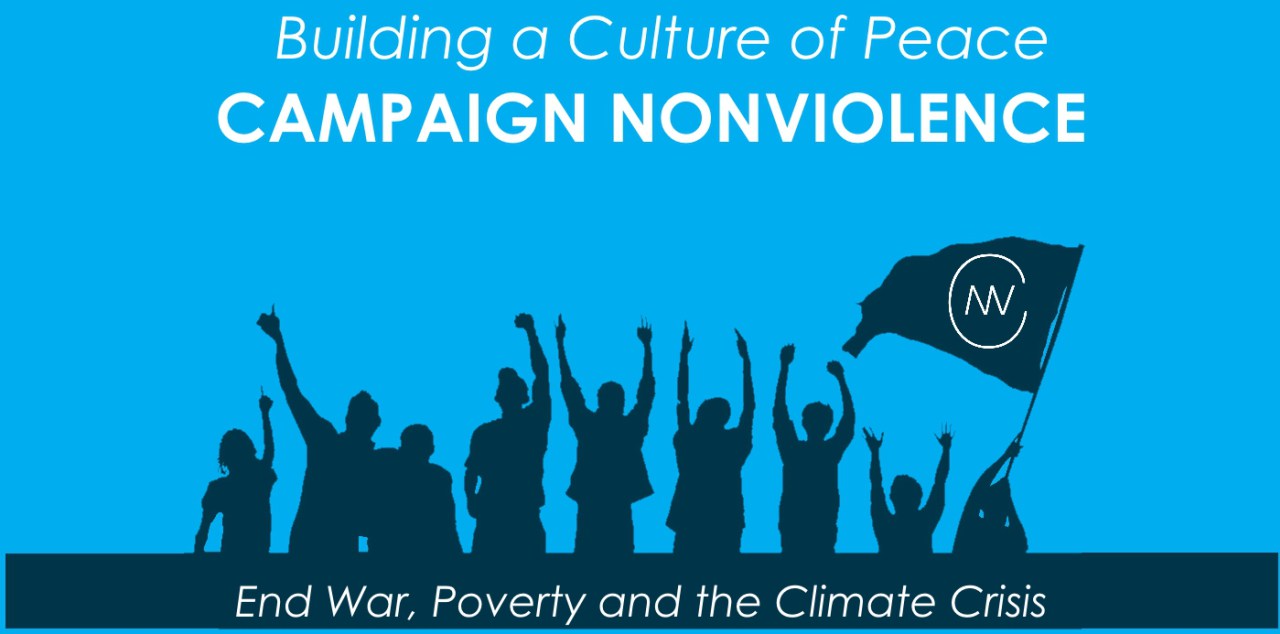
It’s a world we want to live in. How about you?
A big vision like this takes a big movement. And Campaign Nonviolence Action Days is growing. Join us.
Rivera Sun is the editor of Nonviolence News, the author of “The Dandelion Insurrection” and other novels, and a nationwide trainer in strategy for nonviolent movements. www.riverasun.com